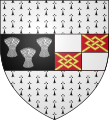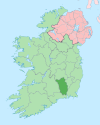Portal:County Kilkenny
The County Kilkenny Portal
County Kilkenny (Irish: Contae Chill Chainnigh) is a county in Ireland. It is in the province of Leinster and is part of the Southern Region. It is named after the city of Kilkenny. Kilkenny County Council is the local authority for the county. At the 2022 census the population of the county was 103,685. The county was based on the historic Gaelic kingdom of Ossory (Osraighe), which was coterminous with the Diocese of Ossory. (Full article...)
Selected articles

Kilkenny (Irish: Cill Chainnigh [ˌciːl̠ʲ ˈxan̠ʲəj], meaning 'church of Cainnech') is a city in County Kilkenny, Ireland. It is located in the South-East Region and in the province of Leinster. It is built on both banks of the River Nore. The 2022 census gave the population of Kilkenny as 27,184, the thirteenth-largest urban center in Ireland.
Kilkenny is a tourist destination, and its environs include historic buildings such as Kilkenny Castle, St Canice's Cathedral and round tower, Rothe House, Shee Alms House, Black Abbey, St. Mary's Cathedral, The Tholsel, St. Francis Abbey, Grace's Castle, and St. John's Priory. Kilkenny is also known for its craft and design workshops, the Watergate Theatre, public gardens and museums. Annual events include Kilkenny Arts Festival, the Cat Laughs comedy festival and music at the Kilkenny Roots Festival.
Kilkenny began with an early 6th-century ecclesiastical foundation within the Kingdom of Ossory. Following the 12th-century Norman invasion of Ireland, Kilkenny Castle and a series of walls were built to protect the burghers of what became a Norman merchant town. William Marshall, Lord of Leinster, gave Kilkenny a charter as a town in 1207. By the late 13th century, Kilkenny was under Hiberno-Norman control. The Statutes of Kilkenny, passed at Kilkenny in 1367, aimed to curb the decline of the Hiberno-Norman Lordship of Ireland. In 1609, King James I of England granted Kilkenny a Royal Charter, giving it the status of a city. Following the Irish Rebellion of 1641, the Irish Catholic Confederation, also known as the "Confederation of Kilkenny", was based in Kilkenny and lasted until the Cromwellian conquest of Ireland in 1649. From 1840 onwards, Kilkenny has not been administered as a city under local government law, but the Local Government Reform Act 2014 provides for "the continued use of the description city". (Full article...)
Selected history articles

The history of Kilkenny (from Irish Cill Chainnigh 'Cell or church of Cainnech/Canice') began with an early sixth-century ecclesiastical foundation, this relates to a church built in honour of St. Canice, now St. Canice's Cathedral and was a major monastic centre from at least the eighth century. The Annals of the Four Masters recorded the first reference Cill Chainnigh in 1085. Prehistoric activity has been recorded suggesting intermittent settlement activity in the area in the Mesolithic and Bronze Age. Information on the history of Kilkenny can be found from newspapers, photographs, letters, drawings, manuscripts and archaeology. Kilkenny is documented in manuscripts from the 13th century onwards and one of the most important of these is Liber Primus Kilkenniensis.
The Kings of Ossory had residence around Cill Chainnigh. The seat of diocese of Kingdom of Osraige was moved from Aghaboe to Cill Chainnigh. Following Norman invasion of Ireland, Richard Strongbow, as Lord of Lenister, established a castle near modern-day Kilkenny Castle. William Marshall began the development of the town of Kilkenny and a series of walls to protect the burghers. By the late thirteenth century Kilkenny was under Norman-Irish control. The original ecclesiastical centre at St. Canice's Cathedral became known as Irishtown and the Anglo-Norman borough inside the wall came to be known as Hightown. (Full article...)
Selected landmarks articles

St. Mary’s Collegiate Church Gowran (Irish: Eaglais Mhuire), also known as the Church of the Blessed Virgin of the Assumption, is a church in the centre of the town of Gowran, County Kilkenny, Ireland. The site is a National Monument in the care of the Gowran Development Association (GDA) and the Office of Public Works (OPW). The church and its family connections have been of huge importance to Gowran and further afield over the centuries. The church is a collegiate church, which means that the priests or chaplains attached to it lived in community together. The present church was not a monastery or an abbey; however experts believe the church was built on the site of an earlier monastery. The presence of an Ogham stone on the site, which is on display in the chancel, suggests there was a place of worship here dating back 2000 years to Celtic times or beyond. (Full article...)
Selected geography articles
Gowran (/ˈɡoʊrən/; Irish: Gabhrán) is a barony in the east of County Kilkenny, Ireland. The size of the barony is 430.5 square kilometres (166.2 sq mi). There are 35 civil parishes in Gowran. The chief town today is Gowran. The barony contains the ecclesiastical sites of Kilfane and Duiske Abbey The barony of Gowran is situated in the east of the county between the baronies of Fassadinin to the north (whose chief town is Castlecomer), the baronies of Kilkenny, Shillelogher and Knocktopher to the west (whose chief towns are Kilkenny, Bennettsbridge and Knocktopher), and the barony of Ida is to the south. It borders County Carlow to the east. The M9 motorway bisects the barony. (Full article...)
Gowran (/ˈɡoʊrən/; Irish: Gabhrán) is a town located on the eastern side of County Kilkenny, Ireland. The historic St. Mary's Collegiate Church is located in the centre of Gowran close to Gowran Castle. Gowran Park race course and Golf Course are located one km from the centre of Gowran. Gowran is located on the R448 regional road (former N9 national primary road) where it is crossed by the R702 regional road. The town is in a townland and civil parish and barony of the same name. (Full article...)
The River Suir (/ʃʊər/ SHOOR; Irish: an tSiúr [ənʲ ˈtʲuːɾˠ] or Abhainn na Siúire [ˌəun̠ʲ n̪ˠə ˈʃuːɾʲə]) is a river in Ireland that flows into the Atlantic Ocean through Waterford after a distance of 185 kilometres (115 mi). The catchment area of the Suir is 3,610 km2. Its long term average flow rate is 76.9 cubic metres per second (m3/s), about twice the flow of either the River Barrow (37.4 m3/s) or the River Nore (42.9 m3/s) before these join, but a little less than the Barrow's flow when it meets the Suir 20 km downstream (over 80 m3/s). (Full article...)
The Barrow Way (Irish: Slí na Bearú) is a long-distance trail in Ireland. It is 100 kilometres (62 miles) long and begins in Robertstown, County Kildare and ends in St Mullin's, County Carlow, following the course of the River Barrow and the Barrow Line of the Grand Canal through counties Kildare, Carlow, Kilkenny and Laois. It is typically completed in four days. It is designated as a National Waymarked Trail by the National Trails Office of the Irish Sports Council and is managed by Waterways Ireland. (Full article...)
Selected quotation
"If you ever go to Kilkenny, Remember the Hole in the Wall, You may there get drunk for a penny, Or tipsy for nothing at all."
|
— Unknown, circa 18th Century. |
Selected Did you know

- ...that Angela Downey won twelve All-Ireland medals?
- ...that James Graves (pictured) was born on St Canice's day, 11 October? (Full article...)
Selected slideshow image
Selected biography articles
Jeremy Hickey (also known as Rarely Seen Above Ground—abbreviated as R.S.A.G.—) is an Irish multi-instrumentalist and producer from Kilkenny. He has released four albums and one EP. Rarely Seen Above Ground (2007) Organic Sampler (2008) Be It Right Or Wrong (2010)Rotate EP (2013) and Chroma (2020).
R.S.A.G released his debut double album Organic Sampler which received a Choice Music Prize nomination for Irish Album of the Year 2008 along with a 5 star review from the Irish Times. His follow up "Be It Right Or Wrong" was also received with critical acclaimed and earned him 5 stars in the RTE ten magazine. 2013's "Rotate EP" was named as one Nialler 9's top 10 EP's that year. His latest album "Chroma" which is hailed as his finest piece of work to date was released on 29 May. The Irish Times calling it 'One of the best Irish albums of 2020'. His live show has been a staple of the Irish Festival scene for years showcasing his talent as a live performer. He has performed at several festivals, including Castlepalooza, Electric Picnic and Body & Soul and is rumoured to be "one of the most innovative and astonishing Irish musicians around" Entertainment.ie (Full article...)
James Stephens (Irish: Séamus Mac Stiofáin; 26 January 1825 – 29 March 1901) was an Irish Republican, and the founding member of an originally unnamed revolutionary organisation in Dublin. This organisation, founded on 17 March 1858, was later to become known as the Irish Republican Brotherhood (I.R.B). (Full article...)
John Comerford (1770–25 January 1832) was an Irish miniature painter active in Kilkenny and Dublin. He exhibited in London at the Royal Academy in 1804 and 1809. (Full article...)
Deborah Alcock (1835– 15 January 1913) was a late-Victorian author of historical fiction focused on religious, evangelical themes. (Full article...)
Selected sport articles
The 2009 All-Ireland Senior Hurling Championship Final was a hurling match played on 6 September 2009 in Croke Park, Dublin, between Kilkenny and Tipperary. It was the first time the two teams had met in the All-Ireland final since 1991. Kilkenny's win was their fourth in a row, an accomplishment last matched by Cork between 1941 and 1944.
Kilkenny's victory gave them a record seventh title of the decade and a record 18th consecutive Championship win. Following the match, Kilkenny manager Brian Cody announced details of the release of his autobiography, Cody. Kilkenny hurler Henry Shefflin was named as the sport's Opel GPA Player of the Month for August after the win; Shefflin contributed 1–14 of Kilkenny's score in the final. Shefflin was named on The Etihad 125 Dream Team before the final. He also claimed his ninth All Star Award. (Full article...)
Related portals
Associated Wikimedia
The following Wikimedia Foundation sister projects provide more on this subject:
-
Commons
Free media repository -
Wikibooks
Free textbooks and manuals -
Wikidata
Free knowledge base -
Wikinews
Free-content news -
Wikiquote
Collection of quotations -
Wikisource
Free-content library -
Wikiversity
Free learning tools -
Wikivoyage
Free travel guide -
Wiktionary
Dictionary and thesaurus































































